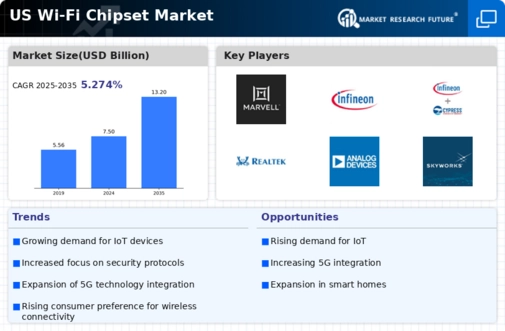Emergence of IoT Applications
The rise of Internet of Things (IoT) applications is reshaping the Wi-Fi Chipset market. As industries increasingly adopt IoT solutions for automation and data collection, the demand for specialized wi fi chipsets has grown. In the US, the number of IoT devices is expected to surpass 30 billion by 2025, creating a vast opportunity for the wi fi-chipset market. These devices require low-power, high-efficiency chipsets that can support continuous connectivity and data transmission. Consequently, manufacturers are focusing on developing chipsets that cater specifically to the needs of IoT applications, thereby driving innovation and growth within the market.
Expansion of Smart Home Devices
The proliferation of smart home devices is significantly influencing the Wi-Fi Chipset market. As consumers increasingly adopt smart technologies, the demand for reliable and robust wi fi connectivity has escalated. Reports suggest that the number of smart home devices in the US is expected to reach over 300 million by 2026, creating a substantial market for wi fi chipsets. These devices, ranging from smart speakers to security cameras, require efficient communication protocols and high-speed connectivity, which in turn drives the need for advanced wi fi chipsets. The wi fi-chipset market must therefore innovate to meet the specific requirements of these devices, ensuring compatibility and performance.
Growth of Mobile Data Consumption
The surge in mobile data consumption is a critical factor propelling the Wi-Fi Chipset market. With the increasing reliance on mobile devices for internet access, the demand for high-performance wi fi chipsets has intensified. In the US, mobile data traffic is projected to grow at a compound annual growth rate (CAGR) of approximately 25% over the next few years. This growth necessitates the development of chipsets that can efficiently manage high data loads while maintaining connectivity. The wi fi-chipset market is thus compelled to enhance its offerings, focusing on speed, reliability, and energy efficiency to cater to the evolving landscape of mobile connectivity.
Rising Demand for High-Speed Internet
The increasing demand for high-speed internet connectivity is a primary driver of the Wi-Fi Chipset market. As more consumers and businesses rely on seamless online experiences, the need for advanced wi fi technology becomes evident. In the US, the number of households with high-speed internet access has surged, with estimates indicating that over 90% of homes are now connected. This trend necessitates the development of more efficient and powerful wi fi chipsets to support higher data rates and reduced latency. Consequently, manufacturers are investing heavily in research and development to create chipsets that can handle the growing bandwidth requirements. The wi fi-chipset market is thus positioned for growth as it adapts to these evolving consumer needs.
Increased Investment in Network Infrastructure
The ongoing investment in network infrastructure is a significant driver of the Wi-Fi Chipset market. As both public and private sectors in the US prioritize the enhancement of digital infrastructure, the demand for advanced wi fi technology is likely to rise. Government initiatives aimed at expanding broadband access and improving connectivity in underserved areas are expected to further stimulate the market. With an estimated investment of over $100 billion in broadband infrastructure planned over the next few years, the wi fi-chipset market stands to benefit from this influx of capital. This investment will likely lead to the development of more sophisticated chipsets capable of supporting next-generation connectivity solutions.






















Leave a Comment